

Cover art by Richard Teschner from Lemuria
Interior art from the Perri Press Fantasy Art Set
Last issue's cover art by Taral was more striking than I realized - OfficeMax refused to print it, saying that the catwoman's breasts were offensive. At least, that's what the cashier said - I never succeeded in speaking to the manager about it. I sent a copy and a letter of complaint to the OfficeMax home office. So far none of the people I sent the zine to have had any adverse comment!
After a couple of indignant e-mails, I finally heard from the local OfficeMax manager, who says it was the machine operator that found the cover offensive. He says he was on vacation and would not have allowed the rejection if he had been there.
This issue's interior art is from a set of 10 postcards made in the late 1940s. Accompanying the set is a note that Dr. David H. Keller wrote a story called The Final War based on this art, which was published by the Perri Press in 1949.
I have begun a scheme to index my fanzines by downloading the existing lists from the Temple University collection and Greg Pickersgill's Memory Hole website. I may be able to get the list of Terry Carr's collection from Bob Lichtman as well. Like my collection, these lists are alphabetical by title - but the lists are ascii files that can be searched with a common editor, so that if I can remember anything about a zine it should be possible to find it.
Lemuria by Karl Hans Strobl, Georg Muller, Munchen 1921, 427pp,
8 plates by Richard Teschner.
Alas, this book is not only in German but in the old Gothic font, so
I may never know just what it has to do with Lemuria as we generally think
of it, that is, a lost civilization. The last plate shows a seated man
with a pipe holding a large book with LEMVRIA on the cover. He seems to
be in a conventional dwelling, with a maid bearing a tray departing in
the background - but the room is full of white rabbits and there is even
one in the back of the maid's apron.
The Contents page gives what must be dates of original appearance or composition, ranging from 1899 to 1916, and the foreword by Leonhard Adelt is dated 1917. Thus this is a collection of stories; and probably a later edition - the 7 bis 9 tausend on the back of the title page would indicate that it was one of the 7-9000th copies. The paper is unfortunately that stuff they learned to make of wood pulp at the turn of the century, and has turned brown and brittle - fortunately the plates are on better stock.
The post of Secretary, which involves day-to-day control of the affairs of the Arthur Machen Society, has passed from Rita Tait into the capable hands of another of the founding committee, the publisher Ray Russell (5 Birch Terrace, Hangingbirch Lane, Horam, East Sussex TN21 0PA, England), and enquiries about membership should be sent to that address.
Hellhopper edited by Janet Fox, Scavenger's Newsletter (519 Ellinwood),
Osage City (KS-66523) 1996, 40pp, illus divers hands in b&w, wraps,
$4.50.
This is the 1996 Killer Frog anthology, a dozen or so intentionally
asinine tales or poems compiled from entries to the annual Killer Frog
contest - there is no entry fee, and the price includes postage. The poetry
is much better than that by McGonagall mentioned in #17...
Comics Revue #130, edited by Rick Norwood and Don Markstein at
the Manuscript Press (Box 336, Mountain Home TN 37684), 64pp, b&w comic
strip reprints, $6.
These are sets of contiguous strips as they appeared in the daily papers
here from every decade back to the 30s - except, for some reason, the 60s.
The 30's are represented by Alley Oop and Krazy Kat, and
the color cover is from Sky Masters of the Space Force by Jack Kirby
and Wally Wood - as with Talbot Mundy's King of the Khyber Rifles,
the first word in the title refers to a person, here a Major Masters
nicknamed Sky. My own favorite of these is Alley Oop by V. T. Hamlin,
though Dick Moores' Gasoline Alley strips from 1974 are better (and
later) than I remembered.
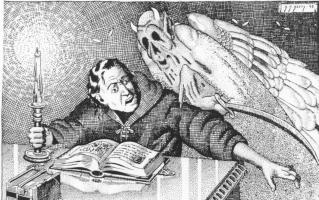
The Escape of Alice by Vincent Starrett, Metropolitan Toronto
Reference Library 1995, 201pp, d/w by Frank D. McSherry Jr.
These are 23 of Starrett's fantasy stories, collected and introduced
by Peter Ruber, in vol.7 of the Vincent Starrett Memorial Library from
the same publisher - MTRL appears on the spine and title page, but the
back of the title page notes that the publisher is The Battered Silicon
Dispatch Box, George A. Vanderburgh (Box 204, 420 Owen Sound Street, Shelburne,
Ontario L0N 1S0, Canada). No price appears - I remember it as $24.
Land O'Goshen by Charles McNair, Wyatt/St.Martin's 1994, 264pp,
$20.95.
A well-written, fast-moving fantasy, set in the southern US in an indefinite
future after the government is taken over by a fanatic religious cult -
and the most radically brutal thing I have read lately, a sort of cross
between 1984 and Texas Chainsaw Massacre.
Arithmetic for Printers by J. Woodard Auble, Indianapolis 1938,
2nd edition, 170pp, illus in line.
A textbook published by the Arsenal Technical Schools where Auble taught.
He notes that this 2nd edition is the first hardbound edition. All the
details of how to calculate the page design for hand-set type, including
the selection of fonts and cost of type-metal and paper and ink. Oddly
enough, Auble seems to think that the word metallic is spelled with
one `l'.
The Temple v.1#1, Winter 1997, ed. by Charles Potts (Box 100,
Walla Walla WA 99362-0033), 80pp, $2.
This neatly-printed pulp-paper zine turned up unsolicited - poems in
English, Spanish, and Chinese. Some poems are given in both Spanish and
English or Chinese and English.
Snark Island Postage Stamps - Ken Lake had me send Gerald M. King a copy of the old Inside article about The Hunting of the Snark, and Mr. King kindly sent me his 1983 catalogue of Snark Island stamps based on this poem. He notes that there are only three sets left - if you hurry you might get one! Address is The Cobbler's Cottage, No.1 The Street, Bramfield, Suffolk IP19 9HT, England.
George Beahm at GB Ink (Box 3602, Williamsburg VA 23187) gave me issues 4 and 5 of his Stephen King fanzine Phantasmagoria, beautifully done. The cover on #4 from The Regulators led me to wonder to what extent King was influenced by the historical Regulator Movement of colonial Carolina.
The Adventures of Meng & Ecker by David Britton, Savoy, London
1997, 256pp, illus, wraps, 9.99.
The editor, Michael Butterworth, kindly sent me a review copy of this
enormous radically nasty British graphic novel. The art is excellent, but
the content is nightmarish; and too frantic and noisy to my taste. I had
a similar problem with Britton's 1996 novel Motherfuckers, 250pp.
No price is given. This beautifully made book is subtitled The Auschwitz
of Oz, and also involves the mutant twins Meng and Ecker but without
illustrations. I tried to read it, but had much the same reaction as to
Norman Spinrad's Bug Jack Barron - like trying to listen to someone
who shouts all the time.
The Savoy books may be obtained in the US from AK Press, Box 40682, San Francisco CA 94140-0682.
Whispers/Weirdbook 30, ed. Stuart David Schiff & W. Paul
Ganley, 64pp, illus. divers hands, wraps, $6.
There is apparently a hardcover edition as well. This is bound in the
topsy-turvy Ace Double format. Beautiful art by Lee Brown Coye, Steve Fabian,
Linda Michaels, Allen Koszowski, and others. This is intended to be the
final issue of both titles - Whispers began in 1973, and Ganley
notes only that his first fanzine, Fanfare, appeared in 1950.
The August Derleth Society Newsletter ($20/yr to: August Derleth Society, Box 481, Sauk City WI 53583) V.17 #3-4, Autumn-Winter 1996, notes that Peter Ruber has retrieved a dozen or so previously unpublished manuscripts from the Derleth home, Place of Hawks, and plans to publish them. At least two, Country Matters and Return to Sac Prairie are already available - probably more by the time this zine appears.
Abandoned in Place by Roland Miller, Huntsville Museum of Art,
1994, 16pp, photos.
This was given to me by the photographer, who I ran across taking pictures
of the 8-Ft Transonic Pressure Tunnel where I worked for 30 years - an
artistic documentation of the decay of the massive structures of the early
space age.
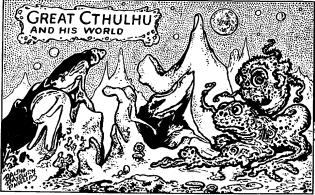
The Three Musketeers by Tiffany Thayer, Citadel Press, New York
1947, 463pp.
A 15th printing of the 1939 edition. The dedication is odd - `To Julia
Sherman / Casanova's mother'. And the action (for which a date is given
for each chapter in the Table of Contents) takes place about 100 years
before Casanova was born. This is not the version of the tale that is usually
filmed - the first chapter has to do with the seduction of a priest by
a nun, and in the second they rob the convent and flee...
Hell on Earth by Robert Bloch, DC Graphic Novels, New York 1985,
wraps, illus Keith Giffen, $5.95.
A comic-book version of Bloch's 1942 Weird Tales story, adapted
by Robert Fleming, with a nice photo of Bloch on the back and blurbs by
Bradbury, Stephen King, Manly Wade Wellman, and Harlan Ellison. A good
story, but the art is impressionistic and slapdash stuff.
Official Guide to the Best Cat Houses in Nevada by J. R. Schwartz,
Boise ID 1996, 182pp, wraps, maps.
Harry Andrushak sent me this, says he's already tried them all and
doesn't need it any more. There seem to be 38 of them from the map on the
back, pretty well distributed over the whole state. Quite frank in the
descriptions of the services offered.
The Dealings of Daniel Kesserich by Fritz Leiber, Tor, NY 1997,
125pp, illustrated by Jason van Hollander with 12 plates and a d/w, $18.95.
This book is said to have been written in 1936 while Leiber was corresponding
with H. P. Lovecraft, lost in the 1950s, and only recovered after his death
in 1992. Short, but well-written and spooky, and the illustrations are
excellent. Only the one on the front of the d/w is in color. The plot concerns
time travel, and the treatment is very sophisticated for the 30s - a bit
like the much later Great Work of Time by John Crowley.
His Share of Glory by C. M. Kornbluth, introduction by Fred Pohl,
NESFA (POBox 809), Framingham MA 1997, 670pp, d/w by Richard Powers, $27.
This massive tome is said to contain all of Kornbluth's short fiction,
which originally appeared mostly in magazines from 1941 (16 of them that
year - he was 18 years old!) to 1958 (the year he died). My favorite is
one of the 1941 stories - The Words of Guru. I read it as a child
in some anthology and its air of cosmic demonism has haunted me all my
life. I see that it takes up less than 6 pages in this book - it starts
in full-speed weirdness with none of the tiresome exposition common to
pulp stories of the time, and ends with a thundering crash. The original
pulp appearance in Stirring Science Stories has a Hannes Bok illo,
though I didn't know that until several decades after I first read it.
It will take me a while to discover if any of the others even approach
it!
The Marvellous Land of Snergs by E. A. Wyke-Smith, Old Earth
Books (Box 19951), Baltimore (MD 21211), xxvi/220pp, illus in line, endpaper
map, and color d/w by George Morrow, Wyke-Smith biography & bibliography,
$35.
I forget now who recommended this - Ben Indick perhaps. It has an introduction
by Douglas A. Anderson and a d/w blurb by J. R. R. Tolkien - another by
Alison Lurie says it is an important source for The Hobbit. This
edition is a facsimile of the 1928 Harper & Bros. edition with a few
errors noted. There is apparently a trade pb edition as well but I do not
have data on it.
The list of typographical errors is not exhaustive - I see that there is a void on p.2 which should have been avoid - but the typography and reproduction are excellent. Morrow's artwork reminds me of E. H. Shepard's.
Edward Wyke-Smith (1871-1935) wrote this book at the request of his children, and it is a juvenile - but of the sort that anyone not too corrupted by TV can enjoy.
Fanthology '92 ed. by Robert Lichtman (Box 30, Glen Ellen CA
95442) for Corflu 13, 42pp, illus in line by Dan Steffan and William Rotsler,
wraps, 1/120.
This reprints 18 articles from 10 fanzines of 1992, all highly opinionated
and most based on accounts of personal experience - Steve Stiles describes
his first orgy, David Thayer writes about Vietnam. Abigail Frost, on the
other hand, presents a theory of what to do with Prince Charles. Excellent
stuff!
To Reign In Hell by Steven Brust, SteelDragon Press, Minneapolis
1984, 257pp, illus. Kathy Marschall, $17.
I have heard of Brust but never read anything of his. Odd for a `Deluxe
Limited Edition' like this to turn up at the local thrift store. The last
page says that it is one of 1000 signed and numbered copies, and while
the first blank page does have `441/1000' written at the top, if the mess
below is Brust's signature he must have some severe disability - it looks
more like where someone tried to get a balky pen to work. There is a foreword
by Roger Zelazny, and the art is not bad - good composition and animal
figures, but the human figures are weak.
The first paragraph of the first prologue (there are two) is worth a giggle at any rate:
Snow, tenderly caught by eddying breezes, swirled and spun into and out of bright, lustrous shapes that gleamed against the emerald-blazoned black drape of sky and sparkled there for a moment, hanging, before settling gently to the soft, green-tufted plain with all the sickly sweetness of an over-written sentence.
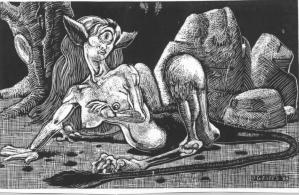
Avallaunius 16 is the Summer 1997 issue of the journal of the Arthur Machen Society, and the new editor, Ray Russell, has done quite a job - it's bound in gold-stamped blue cloth, and has a four articles (with music) on the composer John Ireland who based several pieces on Machen's stories. The address is 5 Birch Terrace, Hangingbirch Lane, Horam, East Sussex TN21 0PA, and dues are 15 pounds sterling in the UK and 18 in the rest of the world. The Society newsletter, The Silurist, has a crossword puzzle and a review of the Joshi biography of HPL.
Liquid Dreams of Vampires by Martin V. Riccardo, 1996, 294pp,
illus., bibliography and index, wraps, $14.95.
As offered on a flyer that appeared in the mail, with the asinine heading
Unearth the mythic power of the vampire within you - a vampiric
self-help book! Apparently the author has gotten together the material
for this book by collecting dreams, nightmares, and fantasies from the
general public. I recently had a Dreamberry Wine from England that
included as postage a color postage stamp honoring Dracula, and asked Mike
Don if, to be fair, they had also done one to honor Van Helsing.
Don't Dream by Donald Wandrei, Fedogan & Bremer, Minneapolis
1997, 397pp, illus. Rodger Gerberding, d/w by Jon Arfstrom, $29.
This was a surprise when it appeared, as I hadn't seen it mentioned
anywhere - it was an `upcoming book' on a flyer that the publisher sent
me back in November and I had forgotten ordering it. The Arfstrom cover
is a rather Powers-like oil, nothing like his sharp pen drawings for old
fanzines. Beside the 26 stories, there are 14 pieces under the heading
`Prose Poems, Essays, and Marginalia'. The nine b&w plates are in the
terminally depressing style of modern horror `art' - I wonder what Wandrei,
who died ten years ago, would have thought of them.
Good stories, one at least in the Cthulhu mythos. Wandrei seems to have been obsessed with protoplasmic vampires and emeralds. There could have been a bit more care taken with the proof-reading - `Atlantic' for Atlantis, `ameba' for amoeba (consistently), `sparked' for spark (at a point crucial to the plot). The stories from the late 30s seem the best to me, while the two from the 60s are all atmosphere with no proper ending and might as well have been included with the prose poems.
A letter with an uncanceled 5k stamp from Nigeria, addressed by hand to `The President & CEO' of Heresy Press (whose entire corporate ouptut was two books that George Beahm and I published on Vaughn Bode and Tim Kirk) turned out to be from a Dr. Yerima Yusuf in Lagos, Nigeria. In all upper case (in point of fact a printed form letter) he requests an `Urgent Business Relationship', to be kept confidential, indeed, `Top Secret'. After some gobbledegook in which he claims to be a member of a government `contract review panel', he proposes that I fax him my banker's name and my account number so that he can deposit $21,320,000 there. These funds are to be shared between myself (30%) and the Contract review panel (60%), with 10% to be used for expenses of the enterprise. No return address appears anywhere, but there is a phone/fax number given, 234-90-407269. It is hard to imagine what sort of idiot would have anything to do with this proposal!
The Untamed, The Night Horseman, The Seventh Man by Max Brand.
These novels appeared as serials in the Munsey All Story Weekly
and Argosy (1920 & 1929) and form a trilogy about a character
named Whistling Dan Barry - there is also a book called Dan Barry's
Daughter. No doubt they have all appeared in pb, though I don't have
any of them. I ran across an excellent column about them by Rick Brooks
(no relation) in his fanzine Nargothrond #1, a beautifully dittoed
production from the late 60s that I glanced through while indexing my fanzine
collection. I am not anything like halfway through - just up to `N' in
the first sorted sequence of the oldest zines.
Rick points out that Barry is a very unusual western pulp hero, a sort of reincarnation of Pan, with supernatural powers and an alien point of view. The first novel was very popular in its magazine appearance, which no doubt inspired the sequels.
I will have to look out for a copy of The Untamed at least - and if anyone knows where Rick Brooks is these days, I'd like to have his address to put on the mailing list.
Another item in the N's of the first fanzine sequence in my collection is a set of the five issues of Manly Banister's Nekromantikon - I see that one of my readers, Herman Stowell King, had a story in the second issue, and that issue also has a poem by Astara Zimmer Bradley. Did Marion Zimmer Bradley (who also had a poem in #4) have a sister?
In the A's of the second sequence, I ran across a letter from myself in Dave Hulvey's 1971 fanzine Afan 2 indicating that I had visited him near Harrisonburg VA - I cannot recover any recollection of that from my aging brainpan! I wonder whatever happened to Hulvey and his remarkable fanartist, Dan Osterman.
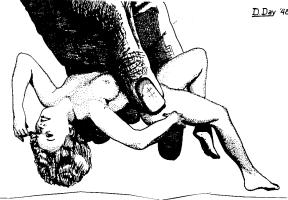
A Boy Fugitive or Fooling His Pursuers, Carrol Moore
or How He Became a Detective, Under a Veil or His Greatest
Mystery, A Desperate Chance or The Wizard Tramp's Revelation,
A Dashing Fugitive or True to His Purpose, and The King's
Detective or A New York Detective's Great Quest by `Old Sleuth',
J.S.Ogilvie Pub. Co., NY nd, 78-93pp each, illus in line, wraps, $0.10
each.
Toni Weisskopf sent me these six, Nos. 52, 77, 85, 92, 100 and 107
of 133 total (according to a list in the back of each) of the series called
Old Sleuth's Own Dime Novels. No date appears, but a Leverett Brown
has written his name and the date 1907 on the title page of each. The books
certainly look 90 years old! They were the same height as a modern mass-market
pb, but about 0.5-inch wider. The paper is not the very coarse stuff seen
in the pulps - it is smooth and only slightly darker at the edges, but
has become very brittle. Each book has only the cover art.
The artwork conforms to the stereotypes of the time - one cover showing a pawnshop owner makes him a stage Jew, and the one on The King's Detective shows a foreigner in cape and slouch hat with beard and mustache. An ad that appears on two of the books offers a book by Judson Taylor called Macon Moore, the Southern Detective, and describes his adventures in pursuit of `moonshiners in Southern Georgia' and his capture by the `Night Riders' - this was an upscale product from the Dime Novel, with 250 pages and costing 25 cents!
These books are not very well written. The reader is expected to know words like homiletic, but there is a shortage of commas, and the dialog is very stilted. The first two are stories involving heirs cheated of their inheritance by dastardly villains. A Desperate Chance also involves an inheritance, and the `Wizard Tramp' is named Brooks - he apparently can't afford any more name than that. But what are we to make of a sentence like `Brooks, who had practically been a bloat had lived a temperate life, had enjoyed plenty of exercise in the open air, and had experienced to a certain extent a return of his original physical strength and vigor.'?
Several of the books carry an ad for another wonderful Ogilvie book, Old Secrets and New Discoveries. In addition to all the secrets of Electrical Psychology and Mesmerism, this tome reveals all of the following - how to make writing appear on the arm in blood characters; how to make a cheap Galvanic battery; how to make a candle burn all night; how to make a clock for 25 cents; how to make yellow butter in winter; how to make Circassian curling fluid (I personally have never felt the need to curl a Circassian); how to make large noses small; how to copy letters without a press; how to make good-burning candles from lard... A whole section is devoted to horse secrets - how to make a horse appear foundered; or lame; or to stand by his food and not eat it; how to cure a horse from the crib or sucking wind; and other antique equine maladies such as the `glanders'. Another section reveals how to make gold and silver from block tin!
The Secret of the League by Ernest Bramah, Specular Press, Atlanta
1995, 287pp, illus., glossary, wraps, $15.95.
This Forgotten Work of Futurist Fiction From 1907, Involving Capitalism,
Wings, And Social War (to quote the cover blurb) turned up in the Laissez
Faire catalog. Sure enough, the only illustration (other than a photo of
the author) shows a woman helping a man get out of his flying suit, on
the back of which can be seen folded mechanical wings; and the action is
set in the author's future 1915-18. So it is certainly science fiction.
The introduction notes that it first appeared as What Might Have Been
by John Murray. The text has been reset, but there is a note that the layout
of the Thomas Nelson editions has been preserved, as well as the British
spelling. They seem to have had a bit of trouble with the typesetting,
the word-spacing is often uneven. The glossary is often useful, though
many of the terms would have given me no trouble. Several proper names
used in dialog puzzled even the glossarist.
Ernest Bramah (Ernest Brammah Smith, 1868-1942) is better known for his stories about Kai Lung, set in China, and a series about a psychic detective, Max Carrados. This story has a great deal of curmudgeonly wit at the expense of the newspapers and advertisements of the time, but the story of the invention of flying is delightfully simple - to a government contest for the invention of a means of flying, a Wynchley Slocombe submitted on a scrap of wastepaper the proposal Strap on a pair of wings and Practise! Practise! Practise!. This turns out to be the key to personal man-powered flight.
On p.22 the hero makes his appearance, rescueing a falling lady aeronaut. He speaks in equations, and glories in the spectacular name of Gatacre Stobalt. But although the heroine is plain Irene Lisle, most of the characters have extremely odd surnames - Vossit, Bilch, Soans, Drugget, Tubes, Strummery... Or am I just stuck with a WASP notion of what is a proper name? I see that the current (Aug'97) issue of Harper's insists that Lockheed Martin has a senior vice president named Holli Ploog.
There is a nice description of the wings: hers were ...of the familiar detached feather - or `Venetian blind' as it was called - pattern, and wonderfully graceful in their long sweep and elegant poise. Made of the purest white celluloid, just tinted with a delicate and deepening pink at the base, they harmonized with her sea-green costume as faultlessly as the lily with the leaves it springs from, while he ...used the more difficult but much more powerful `bat' shape, built up of goldbeater's skin. The goldbeater's skin is not in the glossary, but my Webster's Collegiate explains that it is `the membrane of the large intestine of the ox, used to separate the leaves of metal in goldbeating'. I really must read the rest of this!
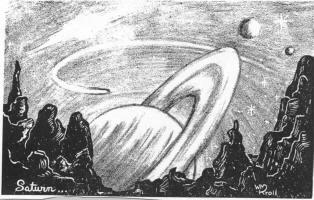
Country Matters and Return to Sac Prairie by August Derleth,
Hawk & Whippoorwill, 1996, 304/331pp respectively.
Nicely made books with Frank Utpatel d/ws - rather like Arkham House
books except that the cloth is green. The price is not given, but the publisher
is George A. Vanderburgh, Box 204, 420 Owen Sound Street, Shelburne, Ontario,
Canada L0N 1S0.
Five volumes in this series from newly-discovered manuscripts have now been published, with a total of 20 projected. Country Matters collects all of the `Gus Elker' stories, while Return to Sac Prairie is a continuation of the `Sac Prairie Saga' books. I probably won't get all the new books, but I did want a few of them. Derleth was a most prolific writer - the list of his titles in Country Matters takes up two pages of small print, nearly 200 books - and he died at 62!
John Collier and Fredric Brown Went Quarrelling Through My Head,
by Jessica Amanda Salmonson, W. Paul Ganley, Buffalo (NY) 1989, 188pp,
illus. by Tony Patrick, $22.50.
An odd and awkwardly long title... The title story is a curious attack
on those two long-dead writers. The 13 or so full-page illustrations are
competent if not striking - they seem a little static to me, as compared
to, say, Fabian's work. Short, gruesome, funny tales!
Arthur Machen by Wesley D. Sweetser, Grosset & Dunlap, NY
1964, 175pp, notes, bibliography, index.
This nice ex-libris copy of the old standard biography of Machen
was give to me by Wolf Dancer, a local fan. This is the G&D library
binding - I have the original Twayne edition. But this copy has a fancy
bookplate signed J. E. McCreary, and he apparently gave it to the `Emerald
Mountain Research Library' on Finch Avenue in Virginia Beach. They acquired
it in 1968, and perhaps it was stolen from them - it isn't marked `Discarded'.
Oho - I see that J. E. McCreary still lives at that address on Finch Avenue,
so the `Research Library' must have been his own thing... Well, I will
send him a copy of this issue and he can let me know if he wants the book
back.
John Whopper The Newsboy, Roberts Brothers, Boston 1871, 128pp.
This anonymous little green-bound book was probably aimed at the humor
rather than the juvenile market. The word `Whopper' refers, then as now,
to a grandiloquent prevarication - in the first chapter John falls down
a shaft and emerges in China. The prose is rather in style of Mark Twain.
I was surprised to see, on p.20, that John did not care to reveal what
he got for his newspapers at the `English and American Coffee-House' in
Canton, because of the income tax - I did not think there was any
such tax in 1871. The book is set double-space with quite wide margins,
and so quickly read. I will not reveal how John escapes after he is trapped
in the center of the Earth - perhaps I will reprint the book if I can find
someone to do suitable illustrations.
In His Image by James BeauSeigneur, Selective House, Rockville
(MD) 1997, 366pp, wraps, $12.95.
This review copy of a trade pb is the first volume of The Christ
Clone Trilogy. I probably would have thrown the promotional material
in the circular file, except that they got a blurb from Charles Sheffield
saying that it is `ingenious and engrossing'. The author is an ex-spook
(two and a half years with the NSA), ex-politician (is that really a curable
disease?) and even (it says) a song-writer. The name is cognate with the
German `Schoenherr' or the English `Fairlord' - hard to imagine how such
surnames arose, they certainly weren't placenames or professions!
The book opens with a novelization of the 1978 investigation into the authenticity of the Shroud of Turin, based on the reports written afterwards. The hero is a journalist who sneaks onto the team of scientists as an assistant to his old med-school professor. The style is a bit turgid, but not that bad as things go in these fallen years - it sometimes seems to me that there are few really good writers still living.
By 1988, the hero's old med-school professor, a devout atheist, has found living human skin cells in fiber samples taken from the Shroud with sticky tape ten years earlier - you can see where we are headed here, I suppose! This first volume of the trilogy runs through the year 2020, and things are just getting started...
Digging to Australia by Lesley Glaister, Atheneum, New York 1993,
214pp, $19.
A strange sort of black comedy about a teenage girl in more-or-less
contemporary England. She has an independent mind and a very odd family,
and neither makes her happy... In the end she retreats into a sort of catatonic
repetition of a nonsense rope-skipping rhyme. Gloomy as it is, the story
is so well written that I was driven to read it to the end.

Caesar's Proscription by Augustus Mansfield Spiers, Stockwell,
London n.d., 127pp.
And signed by the author to a Miss Williams. I think the book must
be pre-WWII, but it's just a guess. The laid paper is very thick, so that
the 127 pages (64 sheets) take up nearly an inch. A Professor Joseph Maerz
of Wesleyan Conservatory in Macon Georgia provides a foreword which he
closes, rather oddly, by predicting that the time is not far distant
when college and university education will, in a large measure, be obtained
from pictures thrown on the screen that will be both educational and entertaining.
There is apparently some historical evidence that in his late teens, Julius
Caesar got crossways with the local poobahs and found himself a fugitive
with a price of ten talents (said to be equivalent to $25,000 whenever
this thing was written - but why dollars rather than pounds sterling?)
on his head `dead or alive'. The interest (if any) is created by the idea
that the `noble Roman youth' Julius was, to quote the page devoted to Leading
Characters of the Production, `destined...to be one of the greatest
men in all history'. Now we begin to see what Spiers and Maerz were after
- they wanted to sell this story to Hollywood.
Alas, as far as I'm concerned Julius Caesar was just another thug who happened to be cleverer or luckier than the competing thugs at the time, for a while - they got him in the end. And this story is very badly written. The narrative is bad enough, and the dialog, full of pointless and idiotic `dost' and `wast' and `blasphemest' and other pseudo-archaic medieval English, is even worse - why would Romans at the time of Christ have spoken bad medieval English? Obviously they would have spoken the local dialect of what later became Italian, and a historical novel in English might just as well stick to plain English.
Son of a Tinker by Maurice Walsh, Chambers, London 1951, 276pp.
Hank Reinhardt got me started on Maurice Walsh - he particularly likes
Sons of the Swordmaker because of the bloody swordplay. The stories
in this collection mostly involve conflict that can be resolved without
bloodshed, though there is one where a man is killed in a duel with small-swords.
It is explained that these have 34-inch triangular-section blades with
needle points, so that they are thrusting weapons only.
My own favorite of the stories is the one called Heather Wine, about the arcane secret of making that liqueur.
The Desert of Ice & Underground City by Jules Verne, H.T.Coates
& Co., Philadelphia n.d., 206/246pp respectively.
The first of these is subtitled The Further Adventures of Captain
Hatteras and has a copyright notice to James R. Osgood & Co., 1874,
while the second is subtitled The Child of the Cavern but has no
copyright notice at all. Both are illustrated by uncredited artists (the
first by `Liou' dated 1866 or 1867, and the second by `Ferat'), and are
identically bound in green cloth stamped in red and gold, with bound-in
ribbon place-markers and t.e.g. Part of a uniform set, perhaps. Underground
City devotes the first 8 pages of a chapter called The Subsoil of
the United Kingdom to a technical explanation of coal and coal-mining!
Something To Hope For by Robert Collier, Collier/`The Book of
Gold', New York 1942, 229pp, illus divers hands.
A sort of anthology of prophesies, some with good illustrations - besides
the ever-popular Nostradamus, there is St.Malachy, Orval, St.Odile, Mother
Shipton, and Joanna Southcott. Five stanzas of Tennyson's Locksley Hall
are reprinted under the same title as the book - `I dip't into the future
/ Far as human eye could see...' and so on. The best art is that done in
the 1880s by a French artist named Robida for the prophesies of St.Odile
and speculations by the Marquis d'Argens.
Go She Must by David Garnett, Sun Dial, Garden City NY., 246pp.
A reprint of the 1927 Knopf edition. Some of Garnett's books are fantasy,
but this one seems to be only a romance.
Incredible Adventures by Algernon Blackwood, Macmillan, New York
1914, 368pp.
Five subtle, mysterious fantasies, in which something wonderful or
terrible seems always about to happen!
Character Sketches by George A. Lofton, Quadri Centennial Pub.
Co., Kansas City (MO) 1890, 454pp, illus.
Alas that the silly pseudo-philosophical pictures in this large moldering
tome are not better printed, I could re-use them. Lofton apparently went
about doing a show where he drew them on a blackboard along with a line
of edifying verbiage. The picture that goes with `Profanity' looks like
the old TV ad for some mouthwash - Don't broadcast bad breath! -
though no TV actor was ever quite that awful-looking.
The Seen and Unseen at Stratford-on-Avon by W. D. Howells, Harper
& Bros., New York, 1914, 112pp.
Subtitled A Fantasy, and some previous owner stuck a piece of
paper in the front saying that it is a first edition. Howells goes to the
Stratford-on-Avon of his own time and begins talking to Shakespeare at
the beginning of Ch.III, without bothering with any nonsense about ghosts
or seances or time machines...
Wassail! In Mazers of Mead by G. R. Gayre, Phillimore,
London 1948, 176pp, illus photos and drawings, notes.
A history of mead, metheglin, sack, and other ancient styles of pop-skull.
A great deal of learned speculation about what the various words for alcoholic
liquors in old manuscripts referred to, but no actual recipes, though the
frontispiece is a photograph of the Mead House at Gulval, Cornwall, where,
it says in the caption, mead is being made in England for the first time
in centuries.
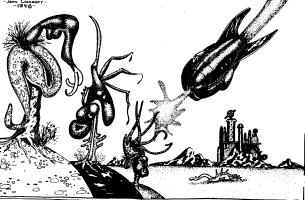
Cahena by Manly Wade Wellman, Doubleday, New York 1986, 182pp,
$12.95.
A first edition buggered up by the Virginia Beach public library. One
of the cheaply-made Doubleday Science Fiction line, it is subtitled A
Dream of the Past. The Cahena was an obscure historical personage of
c.700 AD, a queen of the Moors of North Africa who tried to stop the Mohammedan
invasion. Her army was said to number 40,000. A love interest is provided
by her Saxon sidekick Wulf, who tells the story to French king Charles
Martel many years later, just before the Battle of Tours. The blurb has
it that this short novel was the crowning achievement of Wellman's career
- he died that same year. I don't remember ever seeing a copy before.
I enjoyed this very much, but how is it science fiction, even in the broadest sense? When the attacking Sons of the Prophet shouted `There is no God but Allah!', her tribesmen would shout back `There is also the Cahena!'. Aside from great personal charisma, she had telepathic and healing powers, and was advised by voices that even those nearby could hear. I will not give away the odd twist in the plot. Wellman speculates in the Foreword that the legend of the Cahena may have inspired Haggard's She.
Arrows of Desire by Geoffrey Household, Atlantic Monthly Press,
Boston 1985, 136pp, $12.95.
The US 1st edition of a science-fiction novel set in Britain in the
year 3000. The title no doubt refers to the William Blake poem Jerusalem.
Mr. Wind and Madam Rain by Paul de Musset, translated into English
by Emily Makepeace, Putnam's, New York 1911, 151pp, 25 plates in line by
Charles Bennett, a.e.g., $2.
A reprint from 50 years earlier with the illustrations redrawn and
enlarged from the originals - so was Bennett the original artist? Jack
Hamilton traded me this for three other books. A beautiful example of the
bookmaking of the period, all on coated paper, bound in dark red cloth
stamped in gold. The story, obviously intended for children, is an adventure
involving personifications of the weather, and includes a puppet play.
A magazine called Nova Express sends their Summer '97 issue to IGOTS with the unexplained notation `T/B 16' on the label. Special Duel Interview Issue! TONS of Book Reviews it says on the front. I might imagine that `duel' was supposed to be `dual', as there are two of them, and no duel in sight. The interviews are with Bradley Denton and William Browning Spencer, which with the books reviewed seems to indicate that the zine is aimed at the modern horror wing of the sf market. I read Spencer's Resume With Monsters a while back.
Nicely set with modern DTP software and generally well-printed, though something went wrong with the p.17 inset. Nice gruesome artwork. The newstand price is $4 for 36pp or you can subscribe, $12/4 - Box 27231, Austin TX 78755-2231.
The Wisconsin, River of a Thousand Isles by August Derleth, Univ.
of Wisconsin Press, Madison 1985, 366pp, illus., index, bibliography, map,
wraps.
Originally a 1942 book in the Rivers of America series. Derleth renewed
the copyright in 1970, before he died in 1971. Sauk Prairie is marked on
the map just past where the river turns west to flow into the Mississippi.
It opens with a wonderful description of an early explorer, Jean Nicolet,
landing on the shores of what is now Green Bay - believing that he might
have discovered fabled Cathay, he put on `a grand robe of China damask,
all strewn with birds and flowers of many colors' to impress the local
inhabitants if they should, indeed, be oriental. But he also carried two
pistols in his hands...
1945 by Newt Gingrich and William R. Forstchen, Baen Books, New
York 1995, 382pp, 4 maps, a.e.g.
Toni Weisskopf sent me this, probably as a joke, as she must know from
SFPA that I am not a fan of the Newt. An alternate history of WWII, said
to have been written mostly by Forstchen - one of the maps shows Rommel
invading Edinburgh Scotland from the North Sea. The last page ends with
`TO BE CONTINUED...' - but probably not, as it was apparently a dud in
the marketplace.
Black Majesty by John W. Vandercook, Harper & Bros, New York
1928, 207pp, bibliography, illus by Mahlon Blaine.
Not a rare book, but well worth having for the artwork. It is a novelized
biography of the first king of Haiti, Henry Christophe, who seized control
from Toussaint L'Overture in 1803 and held it until 1820, declaring himself
an emperor and establishing an aristocracy.
Jungle Girl by John Moore, Collins, London 1958, 128pp, 12/6.
Like the previous book, this was sent to me by Tom Cockcroft, who knew
that I collected John Moore. Moore is a British regional writer, and nothing
to do with sf at all, but I like his writing. I have many of his books,
but had never seen this one before, though I knew of the title. It turns
out to be a romance novel about a girl and her snakes - she plays the Jungle
Girl in a small traveling circus.
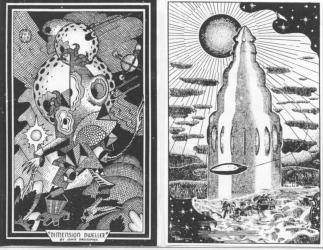
A World Away by Maeve Gilmore, Gollancz, London 1970, 157pp,
index, bibliography, illus photos and Mervyn Peake artwork, 2.00.
This was buggered up and then discarded by the public library in Tom
Cockcroft's home town, Lower Hutt. I enjoyed it very much when I read it
in the 70s. It's a memoir by Maeve Gilmore of her husband, the great artist
Mervyn Peake, who had died in 1968. The d/w art is by Maeve Gilmore. Perhaps
one of the readers wants this copy, identical to my own and apparently
the 1st edition.
The Past by Hugh Fleetwood, Hamish Hamilton, London 1987, 199pp,
10.95.
Another refugee from the Lower Hutt library - beautiful d/w art from
a Hieronymus Bosch painting. I never heard of the author. According to
the blurb it is `a nightmare vision of a world in which the only reality
is sexual perversion, sadism, rape, incest, torture and murder' - a wonder
it hasn't been done as a film yet. Doesn't seem to be very well written.
The March of the Millenia by Isaac Asimov, Walker, New York 1991,
196pp, index, $18.95.
E pluribus unum... One of the few collaborations though - a
Frank White is listed as second author, with no explanation as to what
part he had in it. White is said in the blurb to be a `foremost authority
on space-related issues' - but this book is a brief history of the world,
subtitled A Key to Looking at History. The endpapers display a time-line
from 8000 BC to 2000 AD.
Latest Catalogue, Johnson Smith & Co., Detroit 1936, 580pp.
Do you ever feel the desire to make an "ear-splitting, soul-harrowing,
nerve-shattering noise with which nothing in nature can compare"? To make
"your neighbors rush for their shotguns, dogs start for their cellars,
cats die of envy, and all living beings start up in heart-broken protests"?
Just buy a GREAT DEVELINE WHISTLE, 15 cents, or 3 for 40 cents, or $1.35
a dozen. The wondrous instrument of torture described above is just one
of many gadgets that were available in 1936 when the Johnson Smith Co.
issued their 580 page hardbound catalogue. It is mostly devoted to the
cheap novelty type of item, and the accompanying descriptions and illustrations
are fascinating reading. Some of these things are still available from
novelty supply houses, but others I had never even heard of before, and
there are a few that have become completely incomprehensible in the last
thirty years.
Did you ever hear of the Rolmonica? It was apparently about the size of a pack of cigarettes, and cost $1.10. It used rolls similar to player piano rolls, but much smaller, and was operated by blowing into the mouthpiece while winding the roll by means of a crank on the side. The rolls cost 10 cents each, and the catalog gives a whole page of tunes available. The tune numbers run as high as #618 (SHE'LL BE COMING ROUND THE MOUNTAIN).
Ten pages are devoted to "Harmless Indoor Fireworks", which, nevertheless, could be sent "By Express only". One of these delights is called "The Editor's Wastebasket" - "when lit, goes off with a bang, throwing out variegated confetti and papers".
And then there are the Kazoos. Not just ordinary kazoos, but Cornet Kazoos, Saxophone Kazoos, Baby Jazz Kazoo Saxophones, Kazoo Bugle, etc. While the Cornet Kazoo looks just like the Kazoo Cornet, the Saxophone Kazoo bears no resemblance to the Kazoo Saxophone, and is much cheaper. The group of these instruments in which the word "kazoo" appears first in the title are referred to collectively as "Kazoo Jazz Croonets".
Almost half a page is devoted to the table of contents of AWFUL DISCLOSURES OF MARIA MONK or The Secrets of the Black Nunnery Revealed, and SLAVES OF THE GODSMITH, both evidently anti-Catholic works.
For $1.25, one could obtain a "Hoot-Nanny", which was not a cross between an owl and a goat, but a curious geometric device for making "beautiful and elaborate patterns".
Also for sale is a device called a "Medical Battery", which seems to operate from a dry-cell battery. The current, apparently applied with two large metal electrodes, could "be made as weak as you wish, or so powerful that few could stand it"! It is noted that "physicians tell us that there are few complaints which electricity, intelligently applied, will not fail to benefit"! The emphasis is mine. Read that claim over a couple of times and see what a sneaky thing it is. Along the same line are "Professor Wingren's Voltaic Electric Insoles". These were supposed to be for "aching feet, rheumatism, sweaty feet, etc.", but how they were supposed to work, and where the electricity was to come from, I can't tell. They were apparently about 1/2 inch in diameter and worn on the sole of the foot.
For some things, only the names have changed. What we now call an opaque projector is referred to as a "Radioptican".
There are several interesting books listed, besides the anti-Catholic things above. The Ku-Klux-Klan is exposed for 15 cenys, and there are a couple of books which purport to teach a piano technique referred to as "vamping", with the aid of a "Vamping Board" and a "Vamping Tutor". And there is a 10 cent joke book, which must have really rolled them in the aisles if the examples given are any indication: on the cover, a cartoon showing two men on their knees beside a desk, with a policeman standing nearby; Man: "Say, why don't you help me find my collar button?", Policeman: "I would, but it always gives me the CREEPS!" Others given are: "Why did the sausage roll? - It saw the apple turn over.", and "What is the ugliest tree? - Yew."
And then there are the Anarchist (Stink) Bombs and the Magic Nose Flute... But this is a family magazine.
The preceding account of a book that I should still have (but can't find) appeared around 1967 in Joni Markwood's (later Joni Rapkin) fanzine Zarathustra 7. I found it while finishing up indexing the first sequence of alphabetized fanzines in my collection, and thought I would run it here, 30 years later, to show how much my style has improved. Or not! I see that a second such column (they were called Strange Books I Have Met) appears in Zarathustra 10, about Ashe of Rings by Mary Butts.
Charles Neighbors, President of the Aardvark Literary Agents (3908 Harlem Rd, Suite 104, Amherst NY 14226) writes that they are looking for new writers of fiction. They want the whole manuscript and will sell it for 10%, no reading fee. Website is www.localnet.com/~aardvark/.
Thinking About Magritte by Kate Sterns, Pantheon, New York 1992,
141pp, $19.
Well-written surrealist novel about the city of Limestone and its curious
denizens.
Naked Came the Manatee by divers hands, Putnam's, New York 1996,
201pp.
A reprinting of a novel serialized in the Miami Herald Tropic.
Each of the 13 chapters is by a different writer, most of whom I never
heard of. I bought it in a thrift store because the first chapter is by
Dave Barry. Grotesque and idiotic - which is ok for Barry but the rest
is a waste of time.
Night Lamp by Jack Vance, Tor/Doherty, New York 1996, 380pp,
$23.95.
Great fun, as expected, with Vance's galaxy-spanning technology and
strange cultures (that strangely resemble our own).
A War of Witches by Timothy J. Knab, Harper Collins, San Francisco
1995, 224pp, 1 illus. by Jaime Robles, $22.
An investigation of the underwold of the Aztec witches in Mexico, by
a former professor of anthropology who has become a witch himself. Seems
to be well-written if very odd - I haven't read all of it yet.
Southern Fandom Confederation Handbook, 1997 compiled by T. K.
F. Weisskopf for the SFC, Jackson MS 1997, 122pp, illus photos and cartoons.
An informal history of Southern SF Fandom (back to the dim prehistoric
WWII era), and of the SFC in particular, which dates to the late 60s. Beautifully
laid out and printed in double-column justified, decorated with old photos,
cartoons, con badges, etc. - probably over 100,000 words in this font size.
If interested address Tom Feller, Box 13626, Jackson MS 39236 - I forget
how many they made, or how likely there are to be any left. It was distributed
at the 35th DeepSouthCon - I have been to 33 of them.
Remnant Population by Elizabeth Moon, Baen Books, New York 1996,
339pp, $22.
Toni Weisskopf sent this with the Old Sleuth books mentioned
above. I haven't read much of it yet, but it looks good - when an interspace
corporation pulls contract colonists from an unprofitable world, one old
woman decides to stay behind...
Verdicts Out of Court by Clarence Darrow, edited by Arthur and
Lila Weinberg, Elephant/Ivan Dee, Chicago 1989, 448pp, index, bibliography,
wraps, $11.95.
A collection of the writing of the great attorney (1857-1938). His
style is vigorous and straightforward. His life is a paradox - he was an
agnostic and did not believe in free will, and yet worked all his life
for fairness and mercy in the criminal justice system.
Books wanted by Tom Cockcroft:
Typing completed August 22, 1997. This may be the last IGOTS done with the old FancyFont typesetter - I have ordered a new computer with laser printer and modem. How many readers would be content to get IGOTS off the Net or by e-mail rather than by mail? Can artwork be e-mailed? How do you make a website, anyway? Let me know...
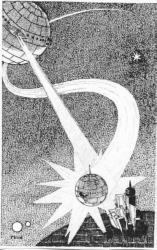
Interior art by D. Bruce Berry, Ralph Rayburn Phillips, O. G. Estes, Donald Day, William Kroll, Ken Brown, John Cockroft, John Grossman, Con Peterson, and Miles Eaton, in that order.